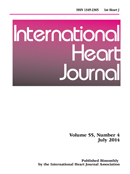Volume 55, Issue 4
Displaying 1-18 of 18 articles from this issue
- |<
- <
- 1
- >
- >|
Reviews
-
2014 Volume 55 Issue 4 Pages 281-286
Published: 2014
Released on J-STAGE: July 10, 2014
Advance online publication: June 17, 2014Download PDF (1829K) -
2014 Volume 55 Issue 4 Pages 287-295
Published: 2014
Released on J-STAGE: July 10, 2014
Advance online publication: June 05, 2014Download PDF (5480K)
Clinical Studies
-
2014 Volume 55 Issue 4 Pages 296-300
Published: 2014
Released on J-STAGE: July 10, 2014
Advance online publication: June 02, 2014Download PDF (916K) -
2014 Volume 55 Issue 4 Pages 301-306
Published: 2014
Released on J-STAGE: July 10, 2014
Advance online publication: June 02, 2014Download PDF (515K) -
2014 Volume 55 Issue 4 Pages 307-311
Published: 2014
Released on J-STAGE: July 10, 2014
Advance online publication: June 06, 2014Download PDF (756K) -
2014 Volume 55 Issue 4 Pages 312-318
Published: 2014
Released on J-STAGE: July 10, 2014
Advance online publication: June 05, 2014Download PDF (519K) -
2014 Volume 55 Issue 4 Pages 319-325
Published: 2014
Released on J-STAGE: July 10, 2014
Advance online publication: June 02, 2014Download PDF (1291K) -
2014 Volume 55 Issue 4 Pages 326-330
Published: 2014
Released on J-STAGE: July 10, 2014
Advance online publication: June 05, 2014Download PDF (515K) -
2014 Volume 55 Issue 4 Pages 331-336
Published: 2014
Released on J-STAGE: July 10, 2014
Advance online publication: June 05, 2014Download PDF (585K) -
2014 Volume 55 Issue 4 Pages 337-341
Published: 2014
Released on J-STAGE: July 10, 2014
Advance online publication: June 05, 2014Download PDF (511K) -
2014 Volume 55 Issue 4 Pages 342-349
Published: 2014
Released on J-STAGE: July 10, 2014
Advance online publication: June 02, 2014Download PDF (766K) -
2014 Volume 55 Issue 4 Pages 350-356
Published: 2014
Released on J-STAGE: July 10, 2014
Advance online publication: June 05, 2014Download PDF (1422K)
Experimental Studies
-
2014 Volume 55 Issue 4 Pages 357-361
Published: 2014
Released on J-STAGE: July 10, 2014
Advance online publication: June 17, 2014Download PDF (1461K) -
2014 Volume 55 Issue 4 Pages 362-371
Published: 2014
Released on J-STAGE: July 10, 2014
Advance online publication: June 25, 2014Download PDF (2131K)
Case Reports
-
2014 Volume 55 Issue 4 Pages 372-376
Published: 2014
Released on J-STAGE: July 10, 2014
Advance online publication: June 05, 2014Download PDF (1416K) -
2014 Volume 55 Issue 4 Pages 377-378
Published: 2014
Released on J-STAGE: July 10, 2014
Advance online publication: June 02, 2014Download PDF (553K)
Letter to Editor
-
2014 Volume 55 Issue 4 Pages 379
Published: 2014
Released on J-STAGE: July 10, 2014
Advance online publication: June 18, 2014Download PDF (450K)
Author’s Reply
-
2014 Volume 55 Issue 4 Pages 380
Published: 2014
Released on J-STAGE: July 10, 2014
Advance online publication: June 18, 2014Download PDF (447K)
- |<
- <
- 1
- >
- >|
